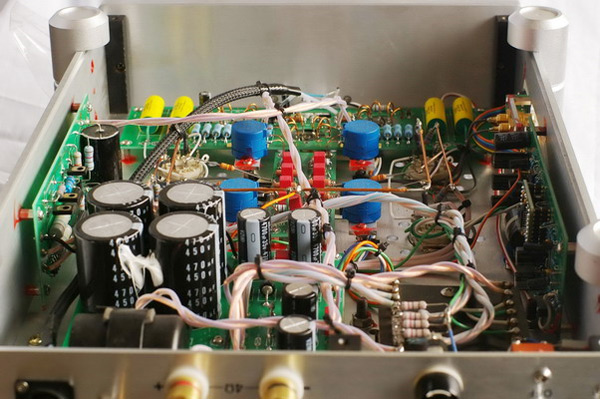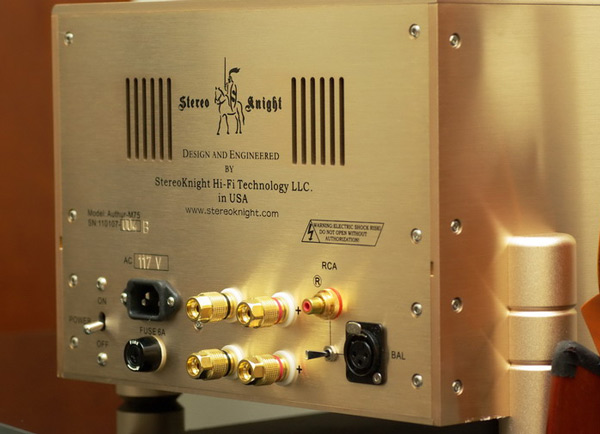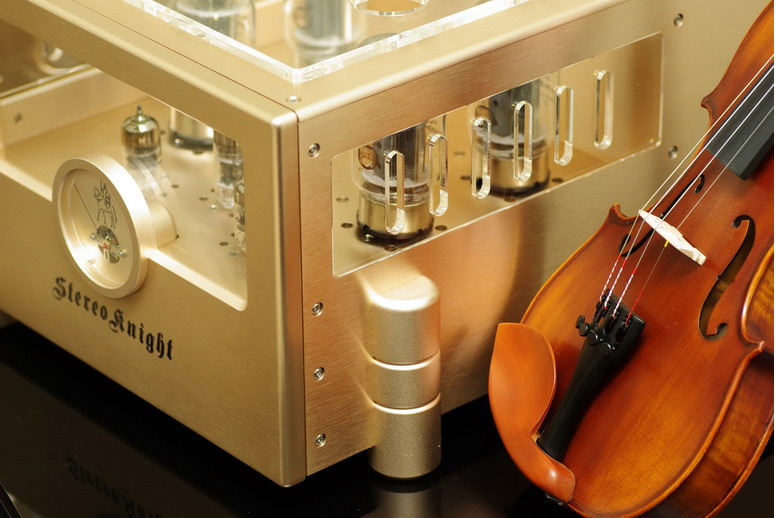
Moving on to “serious audiophile music”, I played Breaking Silence (Analogue Productions APP-027) which seemed to be more human and less of a demonstration disc. There were more tonal inflections and nuance in Ian’s voice. The qualities that make this record an audiophile favorite can take away from the music’s message. With the StereoKnights, the audiophile stuff was handled with an ease that didn’t draw attention to the “sound” of the recording.
Listening to one of the new and improved Classic Records pressings of Duke Ellington and Louis Armstrong Recording Together for the First Time (CLASSIC/ROULETTE SR52074-45QPC, 200g, 45RPM, single sided, clear vinyl—whew!!!), the clarinet of Jimmy Hamilton was as reedy and palpable sounding as I’ve heard in my system. The clarinet is a difficult instrument to reproduce, with a hollow sound that most systems get wrong. The clarinet’s structure suppresses even-order harmonic overtones, allowing primarily odd-order overtones through. This gives the instrument the woody hollow tone. When played back on a tube system that has too much even-order harmonic distortion, the clarinet loses some of its hollow sound. With bad sounding transistors, the clarinet sounds shrieking and aggressive. How much of this was the amp is hard to say, but the M75 has the transparency to allow the appreciation of really good 45rpm vinyl (the closest we will get to the sound of the master tape). I could also pick out multiple distinct images.
Cream’s “Strange Brew” was a riot. There was an ideal amount of bite in the sound. The guitar sound was a perfect combination of body, string and distortion. It didn’t get too forward or aggressive, even when pushed to very loud levels. Clapton’s voice was dulcet, and contrasted with the sound of the ensemble.
On Dark End of the Street by Cat Power (Matador Records, on two 10” LPs), Chan’s voice was as sweet and sensuous as it usually sounds, but now there was more drive. The bass line on the title track was intense. The amps kicked out some serious volume while leaving Chan’s voice unscathed. The cover of Fortunate Son is also excellent. You should pick up these discs as soon as possible. As of this writing, they are still available for $16—that’s chicken feed.
The amp’s ability to image outside the speakers was emphasized on A Night In Tunisia, Art Blakey BST-84049 (45 RPM Music Matters pressing). This album has a massive acoustic space, some of it created by van Gelder’s studio work. Besides the space, there is the issue of handling the tremendous scale of Art Blakey’s drum sound. Between the dynamic contrasts and realistic imaging, it sounded like I was hooked up to a microphone feed on the other side of the recording booth glass.
When going to the Jaton REAL A&V-803 speakers, a relatively efficient 3-way bass reflex design, it sounded like I could achieve rock concert levels with impunity. These speakers aren’t as “picky” as the high efficiency MaxxHorns or the transparent Magnepans. What the speakers do though, especially in combination with the StereoKnight M75, is combine some of the virtues of the big horn and the planar into a package that plays difficult pop and rock music with grace and clarity. I could follow the vocal lines in overly processed recordings, some for the first time. The pairing was very successful with music that can sound threadbare and jumbled together with other combinations.
The Little Partner That Can!
I would be remiss if I didn’t talk about what I feel is the natural partner to the M75 amps, the Silverstone-Balance passive transformer volume control. The build quality is first rate. The body is CNC machined from a solid billet, the Teflon coated copper wire used is meticulously soldered, and the Elma switch is about as good as money can buy.
The unit is configured for either zero or 6dB of gain. I preferred the sound of the unit in the 0dB gain setting, where the bass seemed a little firmer and deeper. You can choose between balanced inputs and RCA inputs. It has one set of balanced outputs and RCA outputs (again, you must choose one or the other).. When I switched between my tube preamp, my stepped passive resistor attenuator and the Silverstone-Balance, I much preferred the sound of the Silverstone-Balance. There was no noise, better bass and dynamics, and no added midrange grain that I heard with the active tube preamp. I heard no limitations in the highs or the lows with the Silverstone-Balance. The sound of the Art Audio Vinyl Reference driving the Silverstone-Balance, into the M75 monoblocks, all wired up with Purist Audio cabling, was some of the quietest and cleanest sound I’ve had.
An interesting point to make about the Silverstone-Balance is that you can hook either a single-ended RCA or an XLR to the input of the preamp, and then drive the input of the power amp with an XLR, bypassing the built-in phase splitter transformer. Regardless of whether I used the Silverstone-Balance with single-ended or balanced inputs, the sound was superior to driving the M75 with a single input driven by the passive ladder volume control or active preamp. I’m sure some of this is due to the nice cables on loan from Purist Audio Design, but the majority was the excellent transformer volume control.
Time didn’t permit me to audition the Silverstone-Balance with other amps, but I wouldn’t be surprised if it were an affordable option that stands toe to toe with the best preamps in the world.
The First True Love
There was a reason that I became an audiophile. It wasn’t that I like pretty equipment, or spending large sums of money. Music is my first love. Back when I thought girls were nasty, before my hormones kicked in, there was music. I was lucky to grow up in an environment that exposed me to stimulating sounds. My parents were both musicians and my father had the hi-fi bug. Mother was a band director, and who knows how those sounds might have affected me before I was even born. I grew up with good music and sound. But sometimes it becomes an effort to listen.
Aren’t there times when you ask: Do I need to turn off the system and give it a break? Am I trying to “one-up” my audio buddies? Am I trying to play “sophisticated” music and thereby gain approval from a musical snob? These are questions I ask myself when my mind starts to wander while listening. Thankfully, some components and recordings revive the excitement that got me into this hobby. Just as I was getting into another listening funk (funk meaning blah, not like George Clinton or James Brown), the StereoKnight amps rekindled the flame.
I believe these amps combine virtues that you would find in totally different design topologies, such as the grace of a 300B amp with the bass grunt of a solid-state design. They feature “name brand” parts and expensive machine work, but don’t cost what you would expect to pay for a name-brand amp of similar sonic qualities. The only time I got them to sound ugly was when I tried to clip them on purpose (with Dark Side of the Moon). It would’ve been more shocking had the amps not ran out of steam.
There were minor quibbles. Occasionally, when driven with the RCA inputs, the amps had a slightly wooden bass quality. Then, there is the issue of the aesthetics. I prefer black. However, these are picayune critiques. Both the amp and transformer volume control are highly recommended and I will be sad to see them go. Not all products that come through tempt me to purchase them, but these did. Honestly speaking, if I had the extra cash, they’d be mine. Maybe later this year? Here’s hoping the stimulus bill works!
- ← Previous page
- (Page 2 of 2)



Thank you for the M-75 review, I am about to purchase a pair of M-100’s after reading about the 75’s, for the life of me I cannot find anything on the net regarding these amps, Can anyone enlighten me and point me in the right direction please.
Thank You
Phill.
Sorry to tell you, but they went out of business. This economy has killed many little companies the last 6+ years. I really liked the product, and all the people, but they had difficulties with getting distribution, dealers, reviews, etc.. because of a cultural disconnect. They were all from China and weren’t used to dealing with reviewers and dealers. It’s fairly black and white to them: “We have a great product”. In China, where people tend to be more results and value oriented, it makes perfect sense. My stuff is better, so you should buy it. Unfortunately, there are other great products and a limited market here, so you must go beyond “We have a great product”. It’s sad because the product sounded really good, was well built, and the prices were reasonable.
Thank you for the reply, I have since purchased the M-100’s and they are fabulous, they really DO IT for me.
Apparently the designer has a new company and name ‘AM Audio’ and has brought out new models that are really breathtaking, A couple of friends have purchased the new 50 watt class A monos, one standard the other silver wired and are both deliriously happy with the result.
Regards
Phill.
Hello
I’ve just bought a Stereo Knight M-40, their integrated amp. It didn’t come with any instruction or explanation for biasing the output tubes. I’m aware of the 1-4 switch and rca connectors on the side, and the tweaks by the tubes, but no procedure. Can anyone help please?
Thanks
Ron